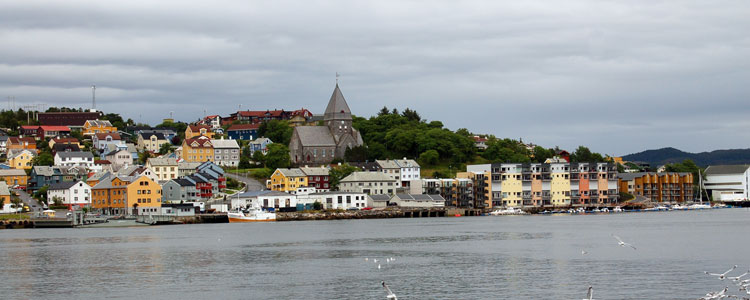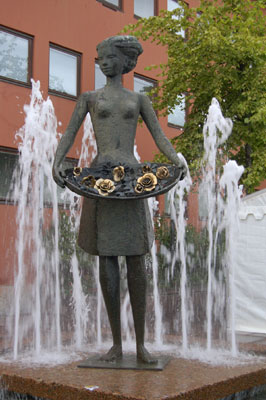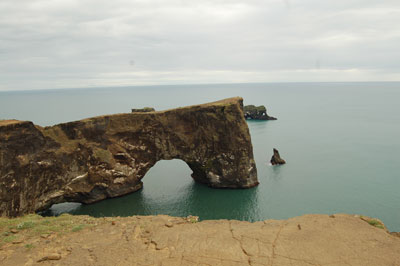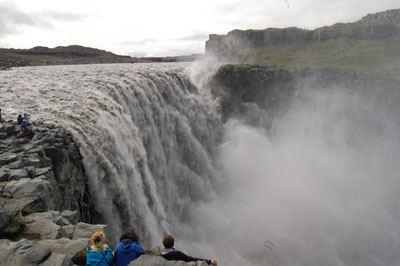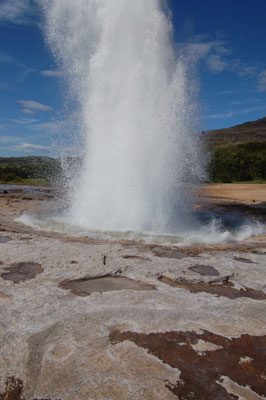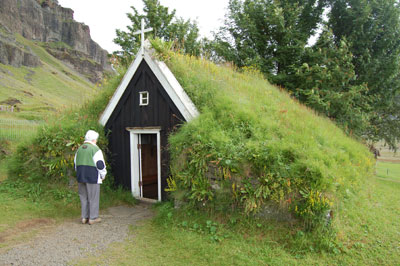Awed by the natural beauty of Norway and Iceland
by Judith Anshin, Contributing Editor
For most people, “summer in Europe” evokes images of long lines for museums and tourist sites, fully booked hotels, busy airports and crowds, crowds, crowds. But in July of 2008 and 2009 I went to parts of Europe that were blissfully uncrowded and had great weather: Norway and Iceland.
Norwegian voyage
In 2008 I took the “Grand Norwegian Coastal Voyage” on the Hurtigruten ship M/S Trollfjord, sailing from Bergen to Kirkenes and back.
I booked the trip through Vantage Deluxe World Travel (Boston, MA; 800/322-6677, www.vantagetravel.com) because they offered three nights in hotels plus a good price for a single cabin on board the ship.
I paid $4,985 for the cruise and booked my own air. (2010 prices start at $2,099 per person, double, without air.)
Hurtigruten’s vessels are working ships that depart Bergen daily for the 12-day round-trip voyage to Kirkenes, calling at 33 ports and covering 1,330 nautical miles. The ships are lifelines for the coastal communities, ferrying cars, goods and people from town to town.
The M/S Trollfjord, built in 2002, has 304 cabins at various grades of luxury. Each day, however, many locals filled the cafeteria and lounges, traveling for the day for business or pleasure.
While not a cruise ship in the sense that most people think of one, it has cabins that are quite comfortable, the food is outstanding and the crews are exceedingly helpful. There are no casinos or fancy entertainment on board, just the grandeur of the Norwegian coast, ever changing as the ship sails along. Many people stayed up to view the Midnight Sun each day, which did not disappoint.
Shore stops
I boarded the ship in the late afternoon with a minimum of fuss. Our tour manager, Ms. Karin Jans, is a leader without equal. She had several meetings with the passengers to inform us of the procedures on board, and everything worked seamlessly. Karin leads several of these cruise-tours for Vantage each year, and I would highly encourage signing up for one that she will be managing.
The benefit of taking the round trip is that stops made during the night while headed north become day stops on the return south. Each place was so interesting, I would not have wanted to miss any of them.
Some stops were pretty brief, with just enough time to load and unload cars, goods and a passenger or two, so Karin would take us on walking tours to be certain we saw important and interesting things in the time allowed.
There were many shore excursions offered by Hurtigruten, but they could be costly. Vantage offered them at a 25% discount if booked prior to the tour, and I signed up for the Geiranger Fjord trip.
Participants took a tender to the town, boarded buses and headed up and over the mountain through some spectacular scenery on a warm, sunny day. The Trollstigen road was filled with hairpin bends and fabulous views, especially of the Seven Sisters waterfall. I think this was the most beautiful part of the entire voyage.
At other stops I used local transportation, such as in Tromsø to see The Arctic Cathedral. However, a booked excursion is necessary to see North Cape (Nordkapp) because the ship docks in Honningsvåg after the local bus has departed, leaving no other transportation option.
In the early ’70s I drove the length of Norway to North Cape, but seeing it from the water was always a dream and this trip did not disappoint. Outside of Bergen, I didn’t recognize one thing from all those years ago, so it was as if I were seeing it for the first time. I found the scenery spectacular, the people warm and friendly, the seas smooth, the sky blue and sunny and the air pleasant, making for an all-around perfect trip.
Hurtigruten supplies each cabin with a very nice soft-cover book filled with detailed information about the voyage, including maps and wonderful photographs. It’s something I will use to look back on a wonderful holiday as well as to encourage others to take the same trip.
On to Iceland
When I started thinking of making travel plans for the following year, Iceland popped to the top of my list.
I checked past issues of ITN and came across an ad from Borton Overseas (Minneapolis, MN; 800/843-0602, www.bortonoverseas.com). When I called the company, I reached Elaine Peik, who was a delight to work with.
I chose to sign up for the 10-day July “Iceland Complete” tour, which started at $3,009 per person, double, including international air. With a single supplement and add-on airfare from California to New York, I paid $3,972. I had also added a day excursion to Greenland at an additional cost, but it was canceled due to high winds.
Arriving in Reykjavík, I was one of 26 passengers from Europe, Canada and the US. Our guide, Annie Duchene, was a woman from Belgium who had fallen in love with Iceland and had been guiding tours there for many years. Annie spoke English, French and some Icelandic and did a very good job.
She has also started her own company, Ultima Iceland (www.ultimaisland.is), and will focus on places that the big tour operators do not cover. And she told me she will never charge a single supplement! I heartily cheered that because a couple of times I and the other single traveler on this trip got short-changed in our accommodations, especially considering we had paid extra but got considerably inferior rooms.
Geothermal effects
Leaving Reykjavík, we had beautifully sunny, clear weather. It was so clear that we could see the Westman Islands quite easily. This is most often not the case, so we were quite lucky.
Our drive through the countryside was most interesting, as we passed the first of many geothermal areas with enormous pipelines that carry the heated water to other parts of Iceland. Almost all heating in Iceland is derived from geothermal energy, and in some places the hot water from the tap was extremely hot.
Most showers that I saw had an interesting type of faucet, with one handle that could be set at a particular temperature and another on the other end that turned the water on and off. This way the hot water was mixed with cold so there was no risk of getting scalded when it came on.
Geysir, the place that has given us the term “geyser,” was a fascinating area of boiling mud pools and erupting hot springs. The original Geysir stopped erupting in the 1960s, so now another geyser, Strokkur, has become the attraction there, erupting about every 10 minutes and reaching a height of 35 meters.
Fabulous falls
Nearby is Gullfoss, considered Iceland’s most impressive waterfall. It is only 32 meters in height, but it covers a broad expanse, and on a beautifully sunny day the spray and volume are impressive.
Later in the day we visited Skógafoss, which drops 62 meters and has a walkway running behind it. The spray reaches out quite a distance, so those who attempt the walk behind the falls or approach too closely from the front should be prepared to get wet.
On this tour we also visited Dettifoss, considered the most powerful waterfall in Europe. Sending up to 400 cubic meters of water down from a height of 44 meters, it creates an enormous spray.
The walk to the waterfall from the parking lot is down many rough steps and the trail is rock and boulder strewn, so it can be difficult for anyone with walking problems, but it was well worth the effort and I really enjoyed my visit.
Goðafoss, known as the Waterfall of the Gods, got its name in AD 1000 when a lawspeaker spent 24 hours meditating on whether or not Iceland should have a national religion. When he decided the country should be Christian, he threw carvings of the Norse gods into the falls, giving them this name.
A lovely stay
Iceland is a volcanic land, and there are still erupting volcanoes as well as ample evidence of past activity. The landscape in many places appears quite bleak, with no trees or vegetation beyond some moss growing over old lava flows, but after a time I came to appreciate it for its unique beauty.
I had to stay an extra night in Iceland because of the Greenland excursion that wasn’t, so Elaine at Borton recommended I stay at the Northern Light Inn (phone +354 426 8650, www.northernlightinn.is). It is very close to the famous Blue Lagoon and a short ride away from the airport, with free transfers to both, so after checking it out online I agreed.
It was my nicest stay in Iceland. The inn was lovely, especially the new wing in which I stayed. It is surrounded by lava fields and close to a geothermal plant, and I really came to enjoy the landscape.
The inn was small, having fewer than 50 rooms, with a wonderfully welcoming, homey feeling. There was a very nice living room and sunroom area where coffee, tea and hot chocolate were available in addition to comfy seats and sofas — perfect for curling up with a book during the long evenings.
Single-room rates range from €100 to €140 ($149-$208), depending on the season. A buffet breakfast was included, as it was at hotels throughout my stay in Iceland, and my dinner in the dining room was the best I had on this trip.
A few standouts
As an animal lover, I really looked forward to, and subsequently enjoyed, a visit to a horse-breeding farm to learn about the famous Icelandic horses. The breed remains pure and dates back to the ninth century, when it was brought to Iceland by the Norse.
For health reasons, once a horse leaves Iceland, even to compete in the Olympics or an international horse show, the animal cannot go back. Instead, they are sold, usually for extremely high prices.
The horses’ most famous trait is a fifth gait, the tölt, which is fast but very smooth. The rider never bounces up and down during this gait and it was a delight to watch.
Probably my favorite part of the tour was a visit to the Jökulsárlón Glacial Lagoon, where we rode amphibious motorized “ducks” into the lagoon among the many icebergs. Annie, our guide, said that two weeks before there were almost no icebergs, but it was quite filled on our visit.
This was an optional activity on the tour but well worth the money (just under $20). It brought back wonderful memories of my trip to Antarctica in 1980.
Summing up
“Iceland Complete” was a circle tour of the island, omitting only the northwestern fjord area. While that meant all one-night stops in hotels, it was a very pleasant trip, offering a nice combination of waterfalls, glaciers, fjords, ancient buildings, remote farms and small towns. We also visited a couple of small museums as well as the original site of the ancient parliament, AlÞingi, founded in AD 930.
I very much enjoyed the town of Höfn and the second-largest city in Iceland, Akureyri. We had free time in both places to explore on our own, which is always nice.
The hotels were quite good, except for one at Lake Mývatn. In one town, a boarding school had been made into a hotel for the summer season and my stay there was very nice.
I’ll be happy to answer any questions by e-mail (c/o ITN). Please put “Iceland travel” in the subject line.

